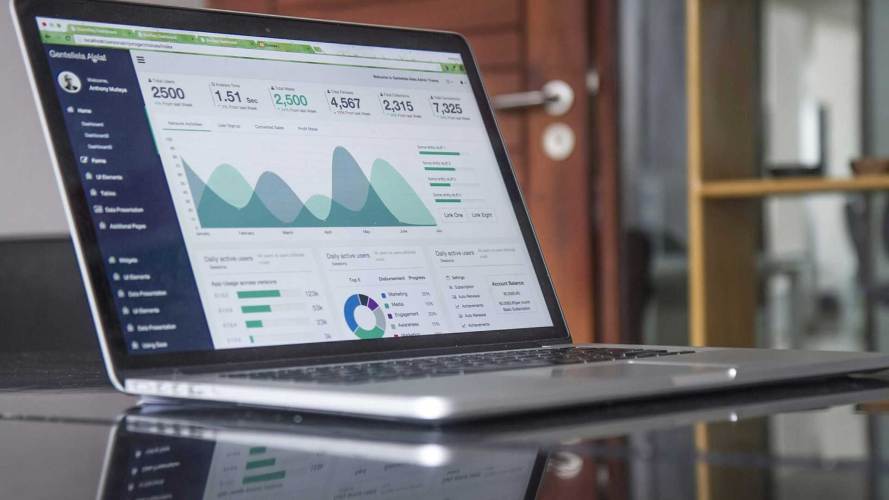What is Sales Projection?



Master the art of sales projections with our comprehensive guide. From understanding the basics to optimising accuracy, elevate your projection strategies today.
Salesforce Staff
It’s no secret that the business world runs on leads, opportunities and sales. But sales managers, sales reps and support staff now have AI-powered CRM tools to do a lot of the heavy lifting.
With so much rich information at our fingertips, businesses can confidently look to the future more accurately than ever before, confidently projecting future financial activity.
One of the most powerful tools in a company’s arsenal is sales projection. In a nutshell, sales projection is simply using your CRM’s real data to develop realistic financial or performance-based predictions.
Why is Sales Projection important?
One of the key reasons to employ sales projection as a planning tool in your business is to empower your management team. Sales projections place your decision makers in the driving seat, ensuring they’re well equipped to effectively plan for day-to-day operations such as KPIs (key performance indicators), budgets and staffing.
When prepared correctly (and we’ll get to that soon), the most significant role your sales projection plays is to describe your potential sales performance and how it aligns with your revenue projections.
Sales projections also give your business a glimpse into the future (crystal ball, anyone?) to see and monitor your business health, productivity and growth metrics. You can see how your business is tracking against target performance, which is reassuring in the best-case scenario.
If performance isn’t meeting objectives, real-time sales data can be the powerful nudge you need to investigate what’s not working and make necessary tweaks and adjustments. This can be due to any number of factors such as pricing, inventory problems or underperforming team members.
The difference between Sales Projections and Sales Forecasts
Sales projections are a little different to sales forecasts. Both are important to use but it is good to know what sets them apart.
Sales projections use current ‘real’ data to gain an understanding of future sales activity. Using the data in your CRM, you can test multiple hypothetical scenarios to examine sales potential, leading to strategic decision-making.
By contrast, sales forecasts use historical data to predict future results or, in other words, they tell us what we expect to see based on past performance.
Advantages of Sales Projections
Sales projections impact all areas of operational business, and really help to gauge the difference between where companies are now, and where they want to be. Bringing sales projections into your strategic planning can provide advantages such as:
- Data-driven decision making. Once your company has examined multiple possible scenarios, you will have a clear idea of what your organisational priorities will be. For example, if you’re looking to expand into a new market and the sales projection figures support this move, you can confidently plan the next tranche of actions to activate this goal.
- Goal setting. Setting the right goals equates to setting your team up for success. Being able to chart potential sales performance outcomes means you can set realistic and achievable goals. Taking your team on the journey to understand the data behind these targets will hopefully inspire them to hit the ground running!
- Staffing predictions. Time really is money, and that statement is never truer than when you’re talking about onboarding the right team. If your sales projections have shown a need to increase or change your staff footprint, the sooner you have this intel, the more chance you have to create the right team and attract the right talent.
- Financial planning. This is probably the holy grail of what accurate sales projections can do for your business. Once your sales projections have supplied the numbers, you can allocate your budgets accordingly to support your organisational objectives.
- Managing product stock. We’ve already discussed how sales forecasting can pinpoint budget and personnel requirements, and this includes managing product inventory. When you can clearly estimate product sales over the coming financial period, you can ensure you have sufficient (but not too much) stock on hand. Inventory control streamlines expenditure against planned sales.
- Optimising customer service quality. Harnessing the power of your sales team is a key benefit and really leverages the value of sales projections data. Arming your sales team with sales projections gives them the opportunity to prepare for all interactions with their customers and to convert those sales.
- Sales team performance. Sales projections provide rich benchmarking and reporting capabilities. Once your sales period has closed, you will be able to measure results against projections. In a perfect world, your results will resemble the projections and meet or slightly exceed them. If actual results fall short, this could mean the sales projections data wasn’t quite accurate or it could reveal barriers to success such as a sales pipeline issue or a staffing dilemma.
Sales Projection optimisation
Now that we know how helpful sales projections are, let’s move onto sales projection optimisation. Broadly speaking, optimisation is simply monitoring and refining through regularly reviewing your sales data, proactively managing your sales pipeline and constantly evolving your sales forecasting.
As your day-to-day business progresses, you will amass solid quantities of sales data. This is going to become one of your best friends in preparing sales projections. Keeping your data as clean and accurate as possible through your collection and organisation process processes will set you up with a solid foundation to start predicting future sales.
Good pipeline management refers to proactively reviewing each stage of the pipeline from leads to opportunities and then to quotes, conversions and sales. Regularly reviewing your pipeline gives you the opportunity to check in on customer progress, to measure results to date and to ensure the data is up to date.
Lastly, you should be constantly examining your sales forecasting model and making amendments and refinements as you go. Your sales predicting process should evolve and grow with your business.
Types of sales projections
There are multiple sales prediction techniques you can apply to get the tailored insights you need, but generally sales projection types generally fall into these categories:
- Historical sales projections. Looking in the rear-view mirror allows you to make predictions based on past sales performance. If you’re tracking year-on-year trend lines and observing an average growth of 12% each year, it is reasonable to apply this business growth estimate for coming years.
- Multivariable sales projections. You can access more nuanced and tailored insights based on a customised view. You can toggle in different factors such as average sales value per customer, current leads and opportunities data, and other sales data can be plugged in to customise the projections.
- Length of sales cycle sales projections. Using length of sales cycle sales projection as technique focuses on who your customers are, what their buyer journey looks like and how they buy your product. You can use your understanding of how long your opportunities generally take to convert and apply this data to your planning.
- Point-in-time sales projections. You can use this sophisticated approach to analyse how your open opportunities are tracking towards conversion. Using a point-in-time approach, you can review factors such as the length of time the opportunity has been open, the number of interactions and cost per opportunity data to predict when opportunities will close (or not).
- Pipeline sales projections. This is where your CRM will really come into its own by providing you with clear insights into expected sales revenue at any given moment. Using the data at your fingertips, pipelines sales projections home in on where your opportunities are at in their customer stage and how likely they are to commit.
Calculating annual Projected Sales
Your company’s financial sales targets are high on any commercial entity’s hit list, so it is crucial to get this right. This is usually the lynchpin upon which everything else hinges so ensuring accurate projections are in place will set your business and your team up to succeed.
Once you have your annual sales forecasting lined up, this baseline data will provide you with the decision-making power you will need to make strategic plans for the year ahead. It will also give you a strong base to lean on through the financial year as unexpected highs and lows unfold.
For example, say one of your suppliers is suddenly unable to fulfil an order you need for production. Your CRM can tell you immediately which of your opportunities may be affected. This knowledge will put your team on the front foot to be able to proactively manage this challenge.
Sales Projection formula
To calculate sales at a high-level, you’re looking at the quantity of goods, products and services sold and multiplying this by its selling price.
Annual sales = quantity sold x price per unit
It is also good to consider your revenue. Revenue is any stream of income into your business, including sales. Sales is just one metric of revenue.
Annual revenue = sales + other income streams
Once your annual sales and annual revenue figures have been determined, you can then continue to consider other financial planning calculations that take operational factors into account such as gross profit, net profit and operating margin.
How to create a sales projection
Creating a sales projection is as simple as following a few simple steps:
- Understand your prospective sales opportunities. When you’re undertaking revenue planning, a key consideration is who your customers are. Knowing what they buy, how often and how they pay for your product (one-off or subscription model) becomes the cornerstone of your sales strategy.
- Review past performance. Looking back at the past few years of sales and revenue performance against targets will set the scene on what is realistic and achievable. Remember, SMART goals! Specifically speaking, delve into metrics to understand your pipeline results. That is, how many leads did you get? How many became opportunities and how many became sales? What about opportunities lost – how many were there and why were they lost?
- Environmental scanning. Your business doesn’t operate in a vacuum! Understanding your environmental factors, market trends and external pressures will provide a layer of depth to your sales projections (and to your financial planning). Being aware of your macro environment in your strategic sales planning will contribute to achievable goals.
- Talk to your people. Your sales team is also a wealth of knowledge you can tap into to get a sense of what it’s like in the trenches. Working collaboratively with your staff can assist in setting realistic sales targets and timeframes, as well as comprehending their capacity to deliver on KPIs.
- Set sales targets. You should now be able to set sales targets based off the research you have conducted. These goals can include anything from number of opportunities, number of sales, year-on-year growth and total sales.
Common sales projection mistakes to avoid
While sales projects are unquestionably useful, there are some pitfalls to avoid. Here are the mistakes we see most often:
- Sales projection data error. Not getting your data right the first time can let you down when reporting against your sales projections. The key takeaway here is to ensure your KPIs align to organisational objectives – you want to ensure your hardworking team knows exactly what they need to achieve. On the bright side, your sales projections can be living data. If you spot something is incorrect early on, there is time to reset and move on.
- Low quality data management. Quality data and data management is almost as important as getting your CRM software! Keep in mind that your CRM is only as powerful as your data management so this is vital to get right. Train your people to ensure data management quality control practices are embedded and upheld.
Sales projection and Salesforce Sales Cloud
If you’re champing at the bit to start work on your sales projections, consider investing in a sales CRM such as Salesforce Sales Cloud – this is where the rubber really hits the road. Salesforce allows you to combine AI, your customer, and lead data with CRM capabilities in a single location. Your customer’s privacy is safely protected, but you get the insights you need.Salesforce Sales Cloud has a rich app-based network of tools ready for you to access and leverage including Salesforce Einstein AI Solutions scoring to triage your leads, generative AI to get ahead of communication and it can even connect into Slack, increasing connectivity between people and pipeline!
Frequently asked questions
What is a sales projection plan?
A sales projection plan is a comprehensive and strategic approach to setting revenue planning goals for your business. You should consider your customer, your product, your sales history, the sales market and external factors and your staff to assist you in setting achievable sales projections.
Why are sales projections important?
Sales projections are important for financial planning, business growth estimates, resource and staff planning purposes. Once your business has a clear sales projection set for the year, sales managers and decision makers can confidently support these goals.
How do you make accurate sales projections?
The best way to deliver an accurate sales projection is with CRM software such as Salesforce Sales Cloud. This CRM is the number #1 on the market and with good reason – powered by AI, Salesforce Sales Cloud can slice your lead, opportunity and sales conversion data within seconds to provide you with customised projection data for your business.



















